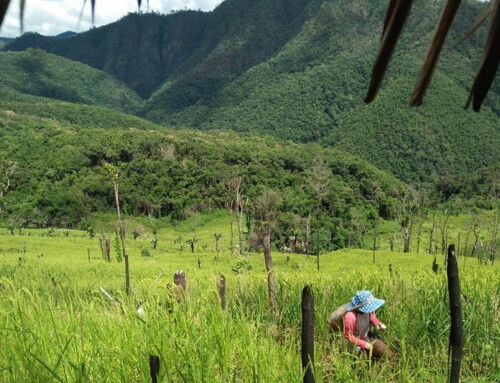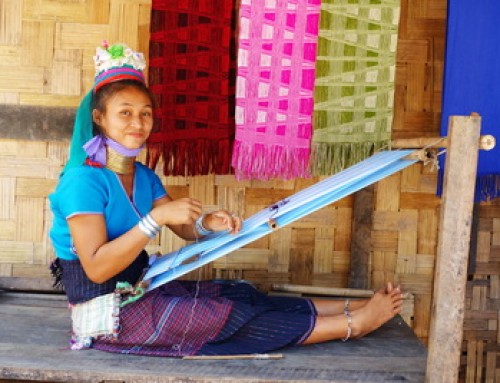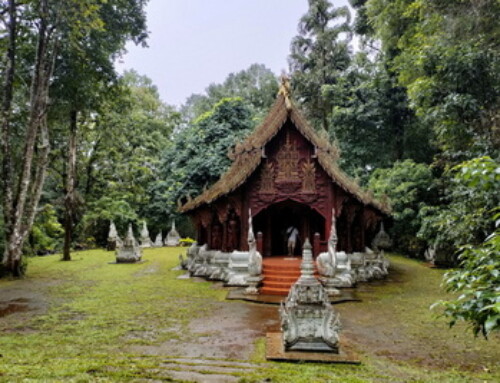Phra That Lampang Luang Temple : The Grand temple of Lampang
Phra That Lampang Luang Temple is a real jewel of Lanna architecture and without a doubt the most beautiful temple I have seen in Thailand!

Phra That Lampang Luang Temple is also one of historical place of Lampang. So apart from going there to make merit and all holy things, you can go there to see historical building and learn history.
The temple buildings seen today were built in the fifteenth century, and one of the reasons for the temple’s popularity is the relatively pure state of all the temple buildings. Unlike most of the temples in Chiang Mai, Wat Phra That Lampang Luang hasn’t been ‘improved’ to conform to modern Thai ideas about temples. The courtyard is still filled with sand, and the huge main wiharn (prayer hall) is still open on all sides The large chedi and prayer chapel of the temple.
To enter the temple, you must pass a pair of guardian lions and climb the naga stairway up to the massive main gate. The main prayer hall, the Wiharn Luang, stands close inside the main entrance. The wiharn is open on all four sides, forming a huge covered hall. Sturdy columns support the roof. The columns are finished in black lacquer and stenciled with gold leaf designs. The gilded ‘ku’ containing the main Buddha image in the wiharn. The ground of the temple is covered with sand, symbolizing the ocean that surrounds Mount Meru.
Attractions in Phra That Lampang Luang Temple

The Viharn Luang
The Viharn Luang, a large building with a three tiered roof was built during the second half of the 15th century. It is open on all sides, which is characteristic of the early Lanna style. The structure is supported by a large number of huge concrete pillars, that have replaced the original teak wood ones. The wooden gable of the front façade is decorated with a Thewada figures, under which are images of water bowls and monk’s fans.
Inside the Viharn Luang pillars decorated with lai kham, gold patterns on black lacquer, support the roof. A very elaborate large golden ku, a structure where important Buddha images are enshrined, is found in the center of the viharn.
The viharn’s walls contain beautiful murals depicting the Jataka tales, the stories about the previous lives of the Buddha.

The Chedi
At the back of the Wiharn Luang sits a massive gilded ku, a sort of Laotian prang sheltering the main Buddha image. The Buddha image is the Phra Chao Lang Thong, cast in 1563. On either side of the Ku are throne-like pulpits, sometimes used by monks but more often used to house other Buddha images on important ceremonial days.
The star attraction in the temple is the 45-meter high chedi, with two shrines on the sides, and a gorgeous wiharn (prayer hall) in front, carved with flowers and leaves, and containing two Buddha statues. The copper and bronze sheet covering has lost its sheen and appears with a touch of green. The structure reveals typical Lanna architecture and design. The open sala has a central altar, stepped roof made of glazed bricks, and carved wooden ‘thongs’ surrounding it. An inconspicuous teak temple hidden in a corner is the Wat Phra That Lampang Luang’s holy section with a little Buddha reportedly made from the same piece of jade as the Emerald Buddha. The walls are adorned with golden patterns, and the extensive use of gold and copper adds richness to this tourist attraction. A museum situated close-by holds many holy artifacts and precious objects.

Wiharn Phra Phut
Wiharn Phra Phut, which is south of the main chedi, dates back to the 13th century and is the oldest structure in the compound. The Wiharn Phra Phut, a small chapel built in 1802 with a beautifully carved fascade. Unfortunately, only men are allowed to see a camera obscura image of the wíharn and chedi in the Haw Phra Phutthabaht. When you close the door, a mirror image of the temple is formed on the wall or the white sheet suspended there thanks to a camera obscura penomenon. The image is projected (upside down) onto a white cloth, and clearly depicts the colours of the structures outside.
Behind the Wiharn Phar Phut is a tiny tower-like structure, the Ho Phra Phuttabat. It houses a Buddha footprint sculpture. The building is generally only open on important festival dates, and may never be entered by women. A 400 year old library building.


The Viharn Nam Tam, Viharn Phra Sao Sila and Viharn Ton Kaeo66
On the other side of the chedi and the main wiharn are three other small open chapels. Although very weathered, both have some rather interesting details and murals.
The Viharn Nam Tam was built at the start of the 16th century. It is believed to be the oldest wooden temple building in Thailand that is still in its original state.
The open wooden structure has a three tiered roof supported by a large number of pillars. The pillars in the viharn’s interior are stencilled with elaborate lai kham decorations. The principal Buddha image is in the Bhumisparsha mudra, and is surrounded by a few standing Buddha images.
The Viharn Ton Kaeo in front of the Viharn Nam Tam is of unknown age. This early Lanna style structure was rebuilt in 1967. It is an open structure with a three tiered roof supported by concrete pillars.

The Viharn Phra Sao Sila is another very old viharn in the early Lanna style. It was probably built in the 14th or 15th century. The open viharn has a three tiered roof, the ends of which are decorated with chofahs in the form of stylized Naga serpents. The front façade that contains a Thewada figure (a kind of celestial being) is intricately decorated in blue and gold colors.
A doorway on the south side of the gallery leads you to several other buildings, as well as the temple’s museum. On the way, you’ll pass an ancient bodhi tree whose branches are supported by a forest of crutches.
The two museums are not very interesting, even though one houses the Phra Kaeo Don Tao, a supposed ‘copy’ of the Emerald Buddha and made at the same time. But it lack most of the subtlety of the Emerald Budda, and the setting doesn’t do it justice. For a close-up look at the Emerald Buddha, you’re better advised to visit Wat Phra Kaeo in Chiang Rai, where they have a recently made copy in a beautiful setting. However, there is a beautiful 400 year old scripture library in amongst the museums that is worth a look
A Must-Go for Whoever Was Born in the Year of Ox
Similar to the Chinese Zodiac conception, Thais also have 12 different animals assigned for each year. Across the Southeast Asian (mostly within Thai Kingdom) continent, 12 sacred temples housing Buddha relics were chosen to represent these zodiac signs. This temple represents the ox and a relic of Buddha’s hair is now being enshrined in the temple’s chedi. If you happen to be born in the year of Ox, come visit Wat Phra Tat Lampang Luang Temple and try to find the enlightenment within.

How to get to the Wat Phra That Lampang Luang
Not too far from Chiang Mai (70km), the elephant conservation camp (15km). The temple is located in Ko Kah district, about 15 kilometers South West of Lampang town, a few kilometers West of Highway 1 (Phahon Yothin road). There is no local public transportation stopping near the temple! So the quickest and most comfortable way to get there is by private car (Private tour to Wat Phrathat Lampang Luang Click). Most hotels or Travel Agency in Chiang Mai and Lampang will be able to book one for you.
Alternatively you can charter a songthaew, a converted pick up truck with benches in the back. A slower, but fun way to get there is by horse drawn carriage, which should cost around 300 – 400 THB. from Lampang town.

To go around the temple and see the local area, charter one of the horse drawn carriages waiting outside of the complex, which should cost around 150 – 200 Thai Baht.
Entrance fee & opening hours
The Phra That Lampang Luang grounds are open from 7.30 am until 5 pm. Admission is free, a donation will be highly appreciated.
Note : Not accessible for wheelchair user
Our services :
Phra That Lampang Luang Temple Map













Leave A Comment